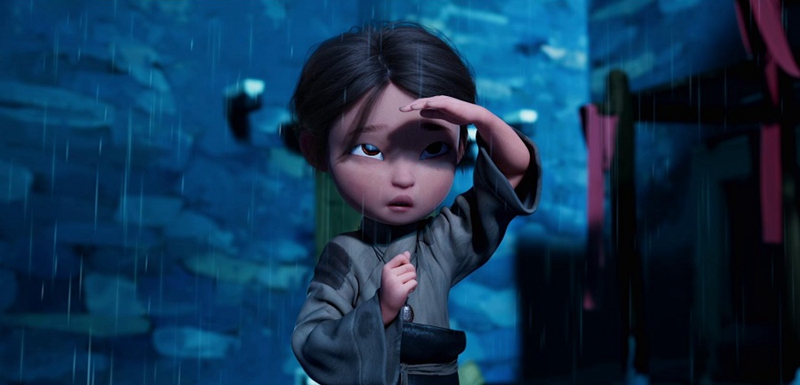In a remote fortress in a fantasy version of ancient China, a young slave girl named Ping forms an extraordinary connection with a dragon. Together, they embark on a heart-pounding odyssey across the breathtaking landscapes of China to evade the clutches of the villainous master. The enthralling narrative, seamless blend of art and technology, and complex character relationships make Dragonkeeper a monumental piece of animation. The China-Spain co-production invites viewers to embark on an exhilarating rollercoaster of emotions in an enchanting adventure.
China Pictorial reached out to two key figures behind Dragonkeeper: executive producer Larry Levene and co-director Salvador Simó, both responsible for bringing Carole Wilkinson’s fantasy novel to screens. As a parent who read the books to his own children decades ago, Levene recognized the potential for an exceptional film adaptation. His extensive experience working in China over the past three decades combined with his profound appreciation for Chinese culture and history shaped his vision for the film. Simó, who directed the Annecy title Buñuel in the Labyrinth of the Turtles, also recognized the appeal of the mythological story because it featured so many elements that children desire in their stories: dragons, magic, and the wonders of Chinese culture that remains relatively unknown and mysterious to foreigners.
Navigating Cultural Nuances
After the co-production process, Dragonkeeper emerged as a “genuine and authentic collaboration,” said Levene. It bypassed typical financial arrangements in which investments are quantified in favor of a true partnership. “From its inception, every aspect of the film was meticulously crafted together.” The objective was clear: to honor the distinct characteristics, history, architecture, and costumes of China during the Han Dynasty (202 B.C.-220 A.D.). This dedication to authenticity presented a challenge in terms of navigating the realm of archetypal characters and ensuring the narrative’s universal appeal. The team dedicated significant time and energy to defining the characteristics of the film’s antagonist because cultural perceptions of good and evil vary so much between regions. Elements such as “mustache design, bird symbolism, and eye shape” became focal points of discussion, and “countless discussions and compromises were undertaken” to strike a harmonious balance.
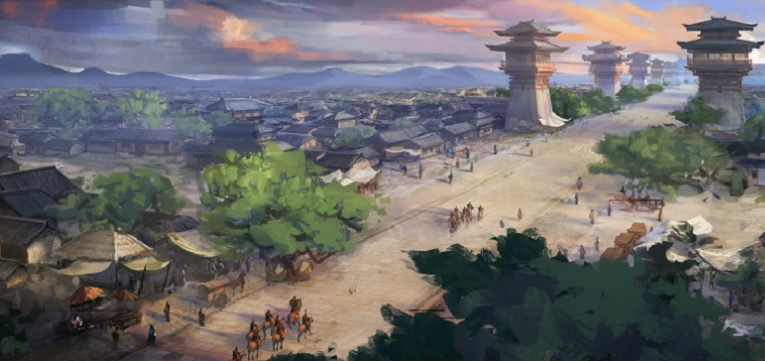
Concept design for Chang’an Road in the capital city of the Han Dynasty. The team endeavored to preserve the film’s Chineseness and safeguard cultural authenticity.
Despite the hurdles in language challenges and cultural perceptions, one of the most fascinating aspects for Simó was the collaborative presence of Li Jianping, the other co-director and head of the Animation School at Beijing Film Academy. Li’s crucial role ensured the preservation of the film’s “Chineseness” and safeguarded cultural authenticity. “Dragonkeeper aimed to bridge the gap between the world’s perception of China and its true essence.” From 2016 to 2017, the joint China-Spain art design team, led by Li, embarked on an extensive research journey across China’s Sichuan and Shaanxi provinces, unearthing invaluable references for architectural structures and historical settings. A profound commitment to accuracy also led to a collaboration with the Central Academy of Fine Arts, whose guidance extended to even the “intricacies of linen and the shapes of shoes.”
Designing the character Ping was an intricate process. Collaborating with Li, Simó explored various possibilities, eventually settling on Li’s suggestion to incorporate elements of a countryside girl through details such as hairstyle. “Our objective was to ensure that Ping resonates with Chinese viewers,” Simó said. “We thought that if she, a Chinese girl, appealed to them, she would captivate audiences worldwide.” This commitment to accuracy and respect for Chinese culture aimed to rectify misrepresentations often found in foreign films and instead offer a faithful and authentic portrayal of China.
For the dragon, a mythical creature lacking fixed representation, early designs leaned towards a more cartoony style. However, the team shifted focus when they engaged the talents of Bill Nighy, a veteran British actor who voiced the character Dragon Danzi. The team sought to convey the essence of Danzi through his facial expressions, reinforcing his role in the film. Danzi, a 1,500-year-old dragon with a wealth of experience, chooses his words carefully and seldom speaks. In contrast, Ping, a spirited and curious young girl, represents the opposite end of the spectrum. Her impulsive nature and desire for instant understanding sets the stage for conflict and propels the story forward. The relationship between Danzi and Ping, the film’s key dynamic, serves as the driving force. The design process involved extensive work to authentically capture the characters’ movements, including how the dragon leaps, walks, runs, and flies.
International cooperation is the heart of Dragonkeeper. “Just as culinary fusion enriches the palate, the blending of cultures brings results in new dimensions and flavors.” Throughout the arduous process of creation and production spanning years, the team behind Dragonkeeper committed to a profound understanding of cultural awareness, which fostered dialogue, debate, and ultimately, consensus.
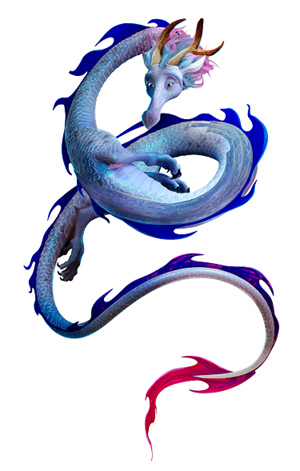
Concept design for Lu Yu, the mate of the Dragon Danzi, who lays an egg just before her death in the film.
Emotionally Charged Adventure
At the heart of the creative concept of Dragonkeeper is strong emphasis on the story and the immersive experience it offers. Limitless possibilities exist in the world of animation, but it can’t be a free-for-all without rules. “The story should always take precedence, and the animation itself is just a tool to enhance the story’s appeal,” said Simó. His primary concern was crafting an unforgettable experience for the audience, offering a “rollercoaster ride of emotions” ranging from happiness and fear to thrills and joy.
Echoing Simó, one crucial aspect for Levene was bringing back the emotional depth that characterized past animation. The contemporary landscape of family entertainment has tended to lean on predictable formulas: fast-paced action, fleeting humor, and a streamlined narrative structure. Unfortunately, this approach often fails to make the heartfelt connection that fosters a lasting impression. With Dragonkeeper, they aimed to break free from the conventions of modern cinema and forge a new path by taking viewers on a breathtaking journey that harkens back to the spirit of movies from the 1990s. Levene’s granddaughter, who shares his love for those classic films, served as a poignant reminder of the profound impact that animation can have.
“A well-crafted animation should not only entertain but also evoke genuine emotions that linger in one’s memory for years to come.”
To achieve this goal, Dragonkeeper blended an “older visual style reminiscent of classic animation with state-of-the-art techniques.” Every frame was meticulously painted by the computer, with strokes of artistry, while the animation itself utilized advanced 3D CEI technology. Importantly, the film doesn’t require viewers to wear glasses, ensuring a comfortable and immersive experience for the audience.
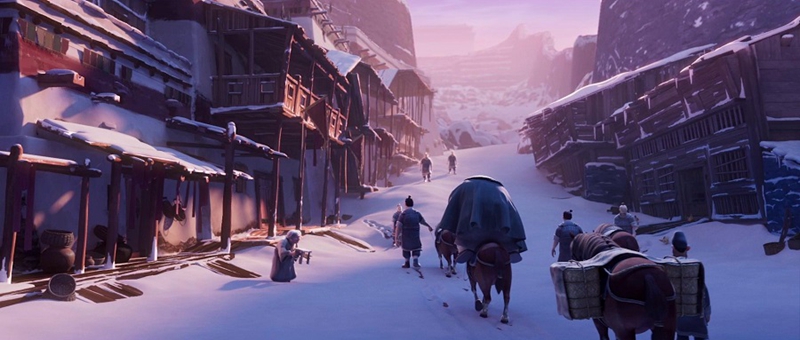
Beneath its modern exterior, Dragonkeeper is rooted in an ancient legend. The story follows a young girl, initially a slave unaware of her own power, who ultimately becomes a brave dragonkeeper. This empowering narrative represents a contemporary tale that reflects the changes and growth experienced by individuals today. As the streaming era ushered in smaller screens and faster-paced content, some of the magic found in grand adventures and sweeping stories began to fade. Dragonkeeper endeavored to reignite that magic and captivate audiences once more.
Dragonkeeper has resonated with audiences on multiple levels, but the true impact varies with each individual viewer. “Every interpretation and insight holds value, and each person’s perspective contributes to the overall appreciation of the film.” Ping’s journey intertwines with a parallel story of one of the film’s antagonists. Both characters yearn to change their destinies but choose different paths, presenting audiences with compelling choices and themes to explore. “With each viewing, new discoveries unfold, enriching the overall experience.”
Levene and Simó have little control over the potential impact of the production on the animation industry, and they both simply sought to make something that viewers would thoroughly enjoy. Other remarkable animated films all contribute to the genre’s growth and evolution in their own way. One such example is I Am What I Am, a Chinese animation they both like a lot. Both animation professionals were surprised that it hasn’t achieved worldwide success despite its quality and innovation. They both consider the film one of the best animated works from China. It explores the essence of Chinese culture, emotions, and traditions. Its style, lighting, and storytelling all captivated them, and they still believe it deserves broader recognition. While Chinese animation has strengths in many areas such as post-production, lighting composition, and visual effects, it still has room for progress. “By embracing opportunities for collaboration and co-production with other countries, the future of Chinese animation gets brighter.”
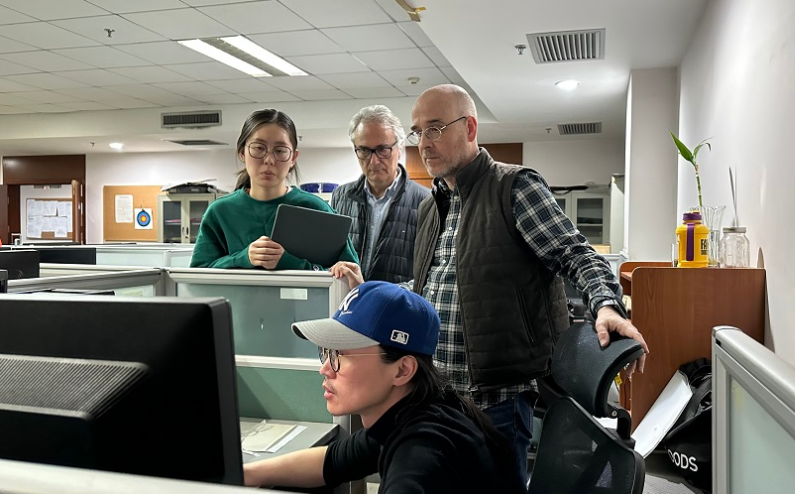
Salvador Simón (right) and Larry Levene collaborate with the Chinese team during the post-production phase of the film.













